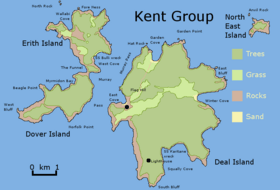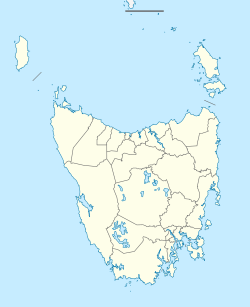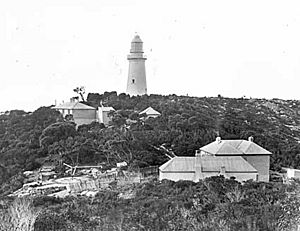Deal Island (Tasmania) facts for kids

Deal Island is the largest of the Kent Group.
|
|
|
Location of Deal Island in Bass Strait
|
|
| Geography | |
|---|---|
| Location | Bass Strait |
| Coordinates | 39°28′12″S 147°19′12″E / 39.47000°S 147.32000°E |
| Archipelago | Kent Group |
| Area | 1,576 ha (3,890 acres) |
| Administration | |
| State | Tasmania |
Deal Island is the biggest island in the Kent Group. It's a large granite island, about 1576 hectares in size. You can find it in the northern part of Bass Strait. This strait is a body of water that separates Tasmania from Victoria in Australia.
Contents
What is Deal Island like?
Deal Island is a special place because it's part of the Kent Group National Park. This park is Tasmania's most northern national park, created in 2002. In 2004, the park grew to include the ocean waters around the three main islands of the Kent Group. This means it protects a huge area of marine life, about 29,000 hectares!
The island has been changed quite a bit by people over time. There's a lighthouse, an old airstrip, roads, and a jetty. You can also find two houses, a dam, and even a museum there.
The Tallest Lighthouse
Deal Island is home to the highest lighthouse in the Southern Hemisphere. It stands an amazing 305 meters (about 1000 feet) above sea level. Imagine how far its light could be seen! Sometimes, people on Wilson's Promontory, 80 kilometers away, could see it at night.
The lighthouse was built way back in 1848. It helped ships navigate for many years until it was turned off in 1992. Because it was so high up, sometimes low clouds would hide its light. Today, the Tasmania Parks and Wildlife Service looks after this important old structure.
A Plane Crash Story
During World War II, on April 26, 1943, something sad happened on the island. A RAAF plane, an Airspeed Oxford, crashed. All four people on board lost their lives.
The plane's wreckage and the crew's graves were found close together at the bottom of a cliff. Later, the crew members were moved and buried in Springvale, Victoria. People who saw the crash said the plane flew very low over what looked like a ship, but it was actually a wreck. Then, it couldn't gain enough height and hit the cliff.
Animals on Deal Island
Deal Island is a home for many different animals. You can find various seabirds and waders that nest there. These include the little penguin, the Pacific gull, and the sooty oystercatcher.
Many mammals also live on the island. Some native animals are the red-necked wallaby, the common brushtail possum, and the southern brown bandicoot. You might also spot fur seals. However, there are also European rabbits, which were brought to the island by people.
The island is also home to several reptiles. These include different types of skinks like the metallic skink, Bougainville's skink, and White's skink. You might also see the white-lipped snake.
Weather on Deal Island
Deal Island has a unique climate because of its location. It's a mix between a Mediterranean climate and an oceanic climate. This means it has mild, short, and somewhat dry summers. The winters are cool and wet. This kind of weather is common for islands that are very exposed to the ocean.
| Month | Jan | Feb | Mar | Apr | May | Jun | Jul | Aug | Sep | Oct | Nov | Dec | Year |
|---|---|---|---|---|---|---|---|---|---|---|---|---|---|
| Record high °C (°F) | 35.8 (96.4) |
32.8 (91.0) |
31.3 (88.3) |
25.5 (77.9) |
23.2 (73.8) |
18.2 (64.8) |
17.2 (63.0) |
20.4 (68.7) |
24.9 (76.8) |
26.0 (78.8) |
33.6 (92.5) |
30.2 (86.4) |
35.8 (96.4) |
| Mean daily maximum °C (°F) | 20.2 (68.4) |
20.5 (68.9) |
19.4 (66.9) |
17.6 (63.7) |
15.6 (60.1) |
13.5 (56.3) |
12.7 (54.9) |
12.8 (55.0) |
13.7 (56.7) |
15.4 (59.7) |
16.8 (62.2) |
18.3 (64.9) |
16.4 (61.5) |
| Mean daily minimum °C (°F) | 14.1 (57.4) |
14.6 (58.3) |
14.2 (57.6) |
12.8 (55.0) |
11.5 (52.7) |
9.7 (49.5) |
8.5 (47.3) |
8.2 (46.8) |
8.9 (48.0) |
9.8 (49.6) |
11.2 (52.2) |
12.6 (54.7) |
11.3 (52.3) |
| Record low °C (°F) | 4.9 (40.8) |
8.0 (46.4) |
3.8 (38.8) |
3.3 (37.9) |
0.4 (32.7) |
−0.5 (31.1) |
−0.5 (31.1) |
−5.5 (22.1) |
−0.2 (31.6) |
5.0 (41.0) |
−4.0 (24.8) |
2.5 (36.5) |
−5.5 (22.1) |
| Average precipitation mm (inches) | 40.7 (1.60) |
38.7 (1.52) |
52.3 (2.06) |
61.1 (2.41) |
73.6 (2.90) |
78.5 (3.09) |
78.5 (3.09) |
73.3 (2.89) |
61.4 (2.42) |
60.8 (2.39) |
50.8 (2.00) |
49.6 (1.95) |
718.8 (28.30) |
| Average precipitation days (≥ 0.2 mm) | 8.2 | 7.4 | 9.7 | 12.4 | 14.8 | 16.0 | 16.9 | 16.4 | 14.5 | 13.3 | 11.5 | 10.0 | 151.1 |
| Source: Bureau of Meteorology | |||||||||||||



